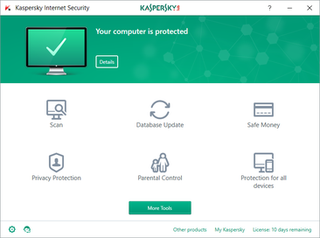Malware is any software intentionally designed to cause disruption to a computer, server, client, or computer network, leak private information, gain unauthorized access to information or systems, deprive access to information, or which unknowingly interferes with the user's computer security and privacy. Researchers tend to classify malware into one or more sub-types.
Spyware is any software with malicious behavior that aims to gather information about a person or organization and send it to another entity in a way that harms the user by violating their privacy, endangering their device's security, or other means. This behavior may be present in malware and in legitimate software. Websites may engage in spyware behaviors like web tracking. Hardware devices may also be affected.
A rootkit is a collection of computer software, typically malicious, designed to enable access to a computer or an area of its software that is not otherwise allowed and often masks its existence or the existence of other software. The term rootkit is a compound of "root" and the word "kit". The term "rootkit" has negative connotations through its association with malware.

In computer terminology, a honeypot is a computer security mechanism set to detect, deflect, or, in some manner, counteract attempts at unauthorized use of information systems. Generally, a honeypot consists of data that appears to be a legitimate part of the site which contains information or resources of value to attackers. It is actually isolated, monitored, and capable of blocking or analyzing the attackers. This is similar to police sting operations, colloquially known as "baiting" a suspect.
Client-side refers to operations that are performed by the client in a client–server relationship in a computer network.

A botnet is a group of Internet-connected devices, each of which runs one or more bots. Botnets can be used to perform Distributed Denial-of-Service (DDoS) attacks, steal data, send spam, and allow the attacker to access the device and its connection. The owner can control the botnet using command and control (C&C) software. The word "botnet" is a portmanteau of the words "robot" and "network". The term is usually used with a negative or malicious connotation.
In computing, Download.ject is a malware program for Microsoft Windows servers. When installed on an insecure website running on Microsoft Internet Information Services (IIS), it appends malicious JavaScript to all pages served by the site.
In computer security, a sandbox is a security mechanism for separating running programs, usually in an effort to mitigate system failures and/or software vulnerabilities from spreading. The isolation metaphor is taken from the idea of children who do not play well together, so each is given his or her own sandbox to play in alone. It is often used to execute untested or untrusted programs or code, possibly from unverified or untrusted third parties, suppliers, users or websites, without risking harm to the host machine or operating system. A sandbox typically provides a tightly controlled set of resources for guest programs to run in, such as storage and memory scratch space. Network access, the ability to inspect the host system, or read from input devices are usually disallowed or heavily restricted.

HijackThis is a free and open-source tool to detect malware and adware on Microsoft Windows. It was originally created by Merijn Bellekom, and later sold to Trend Micro. The program is notable for quickly scanning a user's computer to display the most common locations of malware, rather than relying on a database of known spyware. HijackThis is used primarily for diagnosis of malware, not to remove or detect spyware—as uninformed use of its removal facilities can cause significant software damage to a computer. Browser hijacking can cause malware to be installed on a computer.
In computer security, a drive-by download is the unintended download of software, typically malicious software. The term "drive-by download" usually refers to a download which was authorized by a user without understanding what is being downloaded, such as in the case of a Trojan virus. In other cases, the term may simply refer to a download which occurs without a user's knowledge. Common types of files distributed in drive-by download attacks include computer viruses, spyware, or crimeware.
A registry cleaner is a class of third-party utility software designed for the Microsoft Windows operating system, whose purpose is to remove redundant items from the Windows Registry.

WinFixer was a family of scareware rogue security programs developed by Winsoftware which claimed to repair computer system problems on Microsoft Windows computers if a user purchased the full version of the software. The software was mainly installed without the user's consent. McAfee claimed that "the primary function of the free version appears to be to alarm the user into paying for registration, at least partially based on false or erroneous detections." The program prompted the user to purchase a paid copy of the program.
The Vundo Trojan is either a Trojan horse or a computer worm that is known to cause popups and advertising for rogue antispyware programs, and sporadically other misbehavior including performance degradation and denial of service with some websites including Google and Facebook. It also is used to deliver other malware to its host computers. Later versions include rootkits and ransomware.
Rogue security software is a form of malicious software and internet fraud that misleads users into believing there is a virus on their computer and aims to convince them to pay for a fake malware removal tool that actually installs malware on their computer. It is a form of scareware that manipulates users through fear, and a form of ransomware. Rogue security software has been a serious security threat in desktop computing since 2008. An early example that gained infamy was SpySheriff and its clones, such as Nava Shield.
Honeypots are security devices whose value lie in being probed and compromised. Traditional honeypots are servers that wait passively to be attacked. Client Honeypots are active security devices in search of malicious servers that attack clients. The client honeypot poses as a client and interacts with the server to examine whether an attack has occurred. Often the focus of client honeypots is on web browsers, but any client that interacts with servers can be part of a client honeypot.
The Zlob Trojan, identified by some antiviruses as Trojan.Zlob, is a Trojan horse which masquerades as a required video codec in the form of ActiveX. It was first detected in late 2005, but only started gaining attention in mid-2006.

Kaspersky Internet Security was an internet security suite developed by Kaspersky Lab compatible with Microsoft Windows and Mac OS X. Kaspersky Internet Security offers protection from malware, as well as email spam, phishing and hacking attempts, and data leaks. Kaspersky Lab Diagnostics results are distributed to relevant developers through the MIT License.
Mobile security, or mobile device security, is the protection of smartphones, tablets, and laptops from threats associated with wireless computing. It has become increasingly important in mobile computing. The security of personal and business information now stored on smartphones is of particular concern.
Browser security is the application of Internet security to web browsers in order to protect networked data and computer systems from breaches of privacy or malware. Security exploits of browsers often use JavaScript, sometimes with cross-site scripting (XSS) with a secondary payload using Adobe Flash. Security exploits can also take advantage of vulnerabilities that are commonly exploited in all browsers.
Agent Tesla is a remote access trojan (RAT) written in .NET that has been actively targeting users with Windows OS-based systems since 2014. It is a versatile malware with a wide range of capabilities, including sensitive information stealing, keylogging and screenshot capture. Since its release, this malicious software has received regular updates. It is sold as a malware-as-a-service, with several subscription options available for purchase. Campaigns involving Agent Tesla often start with phishing emails, masquerading as legitimate messages from trusted sources.




